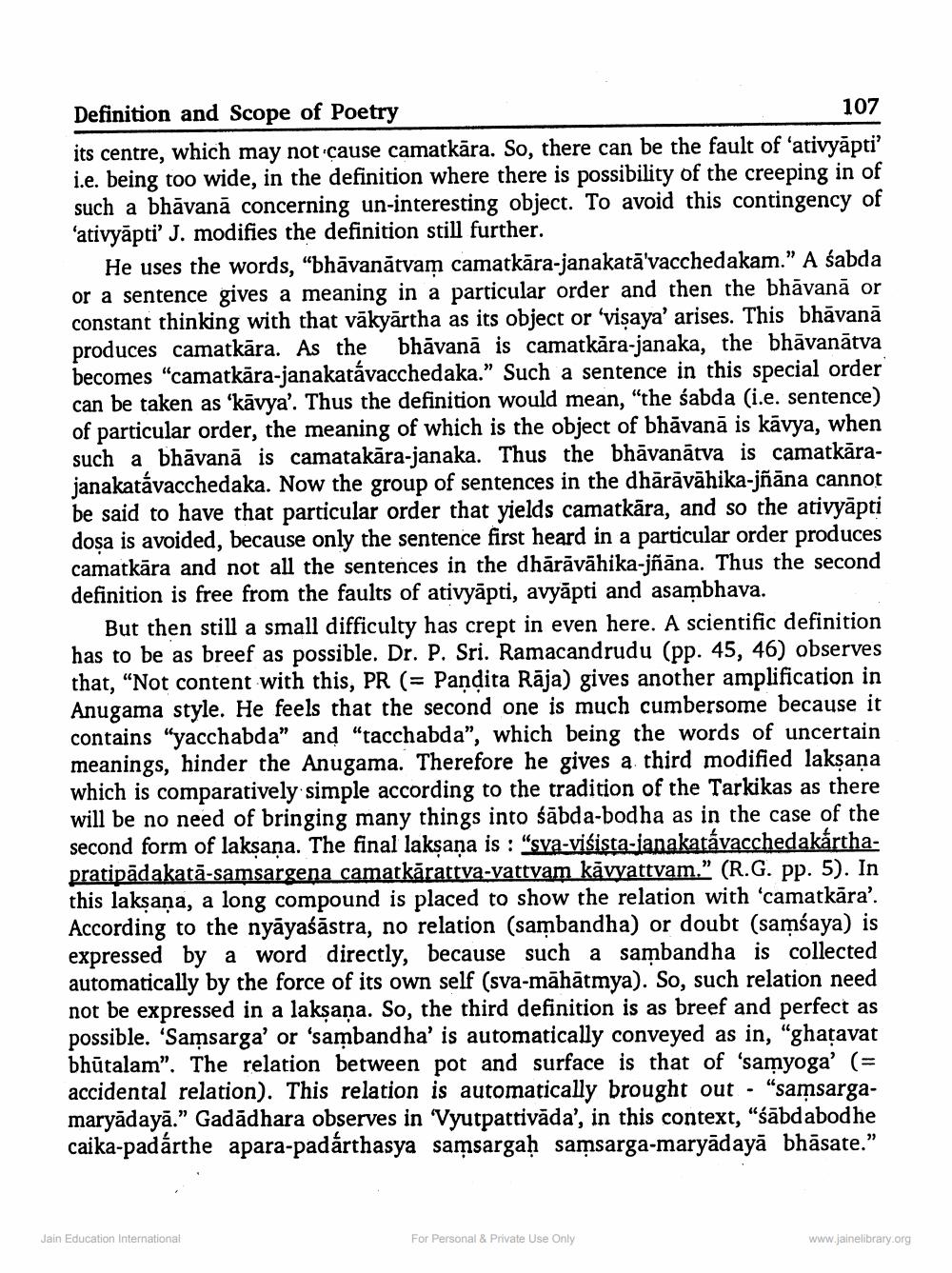________________
Definition and Scope of Poetry
107 its centre, which may not cause camatkāra. So, there can be the fault of 'ativyāpti' i.e. being too wide, in the definition where there is possibility of the creeping in of such a bhāvanā concerning un-interesting object. To avoid this contingency of 'ativyāpti' J. modifies the definition still further.
He uses the words, "bhāvanārvam camatkāra-janakatā'vacchedakam." A sabda or a sentence gives a meaning in a particular order and then the bhāvanā or constant thinking with that vākyārtha as its object or 'vișaya' arises. This bhāvanā produces camatkāra. As the bhāvanā is camatkāra-janaka, the bhāvanātva becomes "camatkāra-janakatávacchedaka." Such a sentence in this special order can be taken as 'kāvya'. Thus the definition would mean, "the sabda (i.e. sentence) of particular order, the meaning of which is the object of bhāvanā is kávya, when such a bhāvanā is camatakāra-janaka. Thus the bhāvanārva is camatkārajanakatávacchedaka. Now the group of sentences in the dhārāvāhika-jñāna cannot
ve that particular order that yields camatkāra, and so the ativyapti dosa is avoided, because only the sentence first heard in a particular order produces camatkāra and not all the sentences in the dhārāvāhika-jñāna. Thus the second definition is free from the faults of ativyāpti, avyāpti and asambhava.
But then still a small difficulty has crept in even here. A scientific definition has to be as breef as possible. Dr. P. Sri. Ramacandrudu (pp. 45, 46) observes that, “Not content with this, PR (= Pandita Rāja) gives another amplification in Anugama style. He feels that the second one is much cumbersome because it contains "yacchabda" and "tacchabda", which being the words of uncertain meanings, hinder the Anugama. Therefore he gives a third modified laksana which is comparatively simple according to the tradition of the Tarkikas as there will be no need of bringing many things into sābda-bodha as in the case of the second form of laksana. The final laksana is : "sva-visista-ianakatávacchedakárthapratipādakatā-samsargena camatkarattva-vattyam kavyattvam.” (R.G. pp. 5). In this laksana, a long compound is placed to show the relation with 'camatkāra'. According to the nyāyaśāstra, no relation (sambandha) or doubt (samsaya) is expressed by a word directly, because such a sambandha is collected automatically by the force of its own self (sva-māhātmya). So, such relation need not be expressed in a lakṣaṇa. So, the third definition is as breef and perfect as possible. 'Samsarga' or 'sambandha' is automatically conveyed as in, "ghatavat bhūtalam". The relation between pot and surface is that of 'samyoga' (= accidental relation). This relation is automatically brought out - "samsargamaryadaya.” Gadādhara observes in "Vyutpattivāda', in this context, "śābdabodhe caika-padárthe apara-padárthasya samsargaḥ samsarga-maryādayā bhāsate.”
Jain Education International
For Personal & Private Use Only
www.jainelibrary.org




